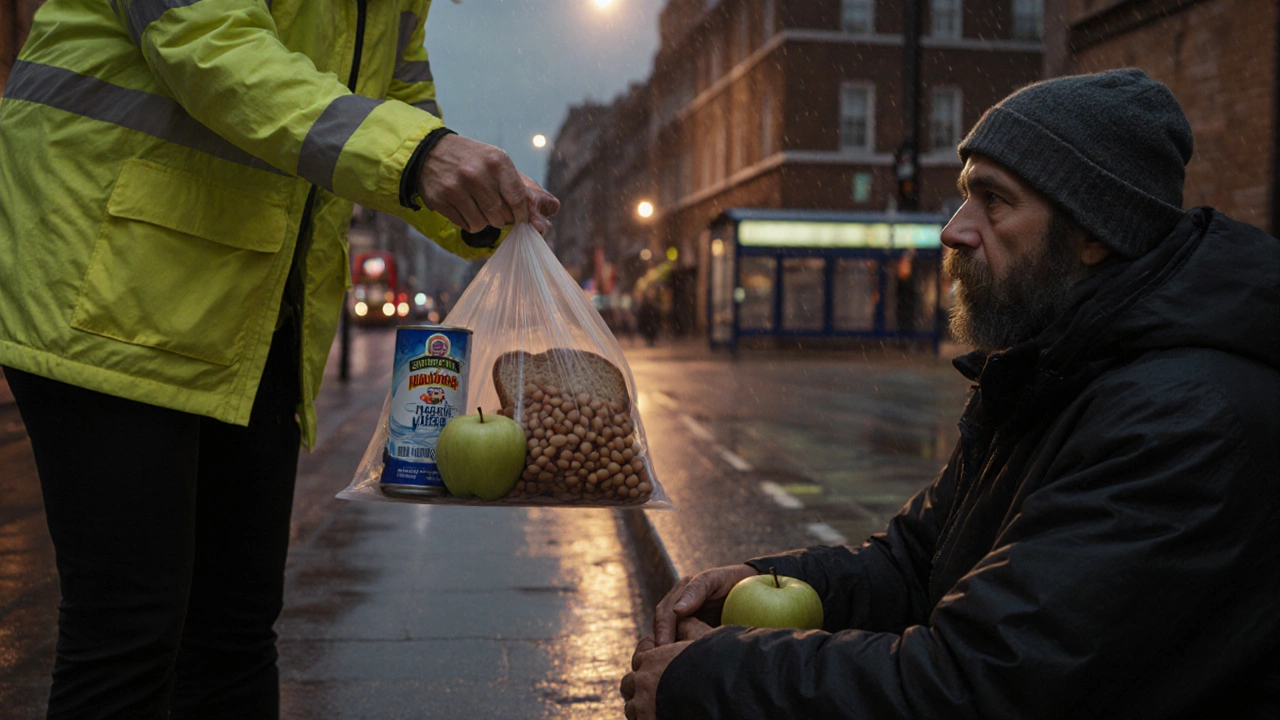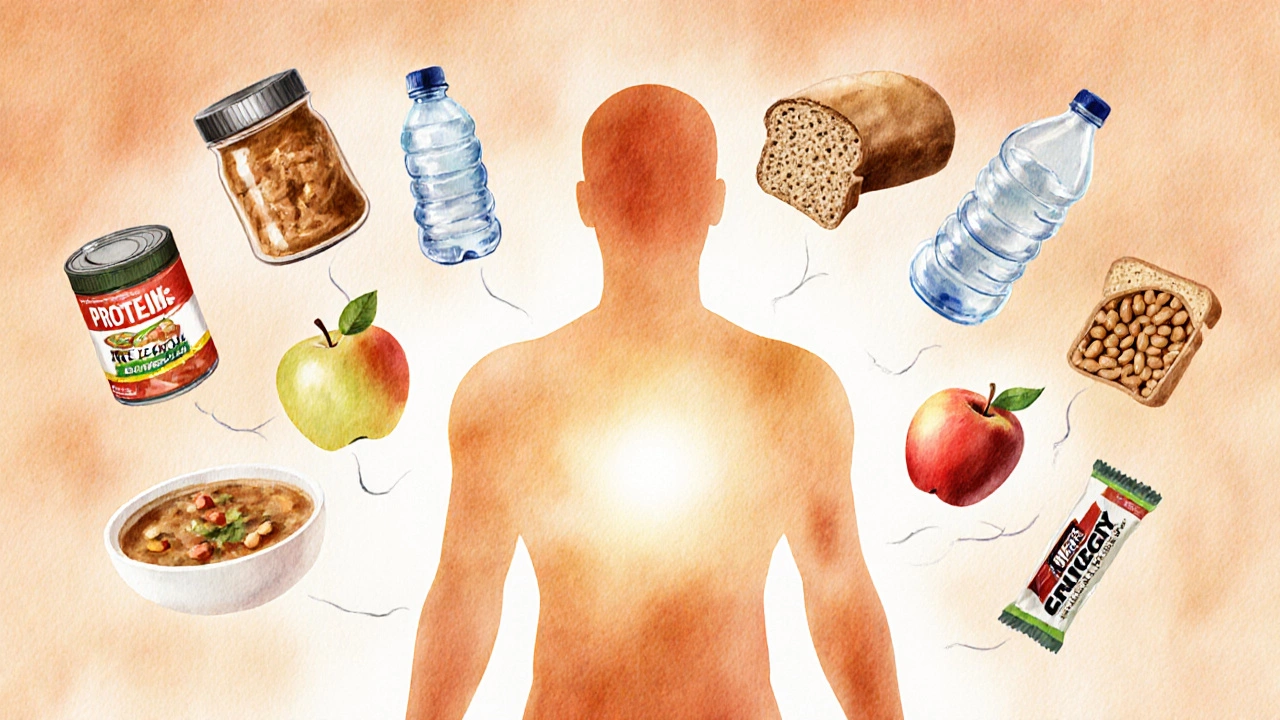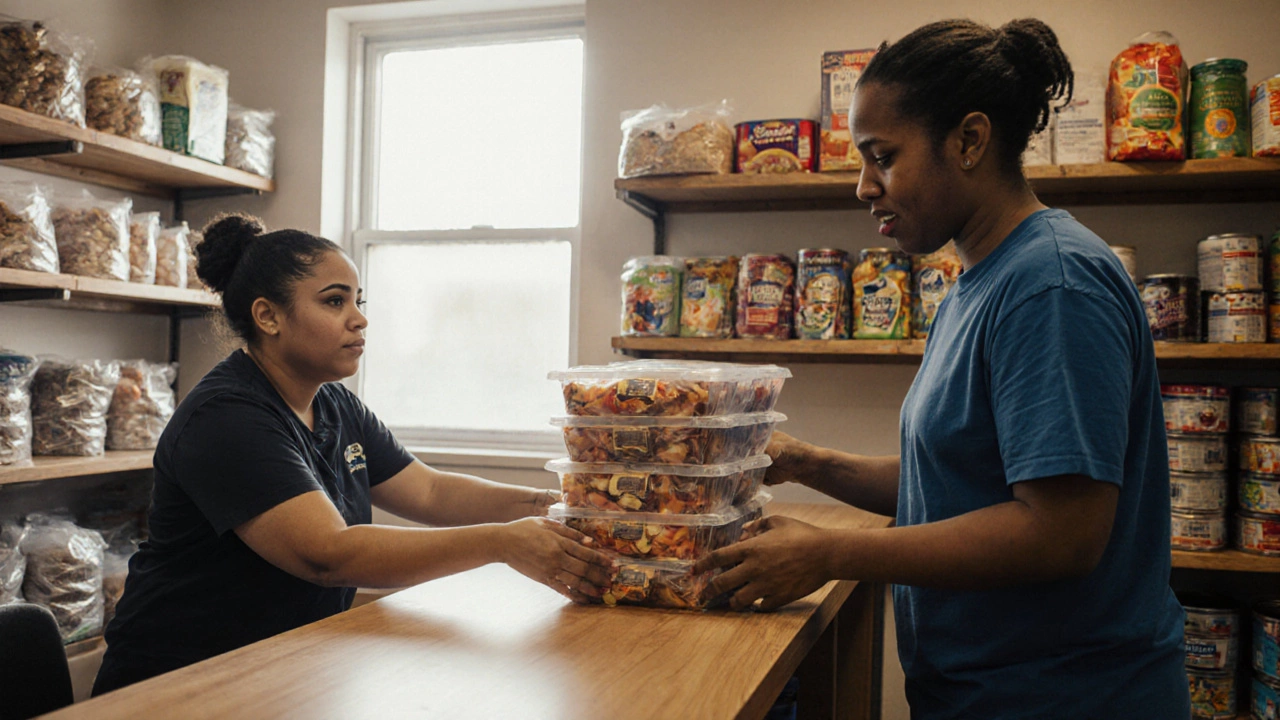Best Food to Give Homeless People: Practical Nutrition Guide
 Oct, 12 2025
Oct, 12 2025
Donation Kit Calculator
Select food items from the recommended list and adjust quantities to see total nutritional value.
Key Takeaways
- Choose non‑perishable, high‑protein foods that are easy to serve.
- Balance calories with vitamins and minerals to support health.
- Package items in individual portions to keep them safe and hygienic.
- Partner with local shelters or food banks for smooth distribution.
- Avoid foods that require extensive preparation or that trigger common allergies.
When you spot someone on the street and wonder what to hand over, the answer isn’t just “any food.” You want something that fills a stomach, fuels a day, and doesn’t create new problems. This guide walks you through the top choices, why they matter, and how to get them into the right hands without hassle.
Homeless person is a individual who lacks stable, permanent housing and often faces limited access to regular meals, clean water, and medical care. Meeting their immediate nutritional needs can make a real difference in health and morale.
Understanding Basic Nutritional Needs
People experiencing homelessness usually have unpredictable eating schedules, high physical stress, and limited cooking facilities. Their bodies need:
- Enough calories to sustain energy for walking, standing in line, or seeking services.
- Protein to repair muscles and support the immune system.
- Vitamins and minerals-especially vitamin C, iron, and calcium-to fight fatigue and illness.
- Hydration, because many rely on public water sources that may be contaminated.
Because you often can’t control how long food will sit before being eaten, the safest bet is items that stay fresh without refrigeration and can be eaten straight from the package.
Top Nutrient‑Dense, Shelf‑Stable Foods
The following foods hit the sweet spot of calories, protein, and shelf life. Each entry includes a brief definition with microdata for easy reference.
- Canned beans are a ready‑to‑eat source of protein, fiber, and iron, typically lasting 2‑5 years on the shelf. Rinse before eating if possible; a single cup provides ~15g protein and 240kcal.
- Peanut butter is a calorie‑dense spread made from ground peanuts, offering healthy fats and ~8g protein per two‑tablespoon serving. No refrigeration needed, and it pairs well with bread or crackers.
- Whole grain bread is a dense loaf that supplies complex carbs, fiber, and some B‑vitamins; it stays fresh for up to a week when sealed. Pre‑slice for easy hand‑out.
- Fresh fruit (apples, oranges) are portable, vitamin‑rich options that can survive several days at room temperature without bruising. Choose firm, unblemished pieces.
- Bottled water is a critical hydrator that eliminates concerns about contamination; a 500ml bottle provides ~17oz of safe fluid. Offer a small pack (2‑3 bottles) to cover a day’s needs.
- Ready‑to‑heat soup cartons are single‑serve meals that require only hot water, delivering ~150‑250kcal and a variety of vegetables. Include a disposable cup and a spoon.
- Energy bars are compact snacks packed with carbs, protein, and often added vitamins, perfect for quick energy boosts. Look for bars with ≤10g added sugar.

How to Package and Distribute Safely
Even the best food can become a risk if it’s not handled right. Follow these simple steps:
- Use clean, sealed bags or containers. Re‑seal resealable zip‑lock bags for items like beans or peanut butter.
- Label each package with a short list of ingredients to help people avoid allergens. Keep labels legible and in plain English.
- Group items into modest “meal kits” (e.g., a can of beans, a slice of bread, a piece of fruit, and a bottle of water). This makes distribution faster and gives a balanced snack.
- When handing out at shelters, ask staff if they have storage restrictions. Some may prefer items that stay dry and separate from other donations.
- Keep a small stock of hand sanitizer or wipes for volunteers to clean their hands before packing.
Partnering with Local Shelters and Food Banks
Doing it alone can be rewarding, but teaming up amplifies impact. Here’s a quick roadmap:
- Food bank is a non‑profit organization that collects, stores, and distributes food to people in need, often coordinating with shelters and community centers. Contact the nearest branch (e.g., Edinburgh Foodbank) to learn their preferred donation list.
- Schedule a drop‑off time that aligns with their receiving hours. Many shelters accept deliveries early morning to stock their pantries.
- Ask if they need specific items - sometimes they run low on fresh produce or prefer low‑sugar snacks.
- Volunteer for a short shift. Seeing the process up close helps you fine‑tune your packaging.
Common Pitfalls and How to Avoid Them
Even well‑meaning donors can make mistakes. Keep an eye out for these issues:
- Allergy blind spots: Peanut butter is nutritious, but many people have peanut allergies. Offer a nut‑free alternative like sunflower seed butter when possible.
- Over‑reliance on sugary snacks: Energy bars loaded with candy‑style sugar cause spikes and crashes. Choose bars with natural sweeteners and added fiber.
- High‑salt canned meals: Too much sodium can raise blood pressure. Opt for low‑sodium varieties or rinse beans before handing them out.
- Perishable items without refrigeration: Fresh dairy or sliced meats spoil quickly. Stick to items that stay safe at room temperature.
- Packaging waste: Over‑packaging creates litter. Use recyclable or biodegradable bags where feasible.

Comparison of Top Food Choices
| Food Item | Calories per Serving | Protein (g) | Shelf Life | Prep Needed |
|---|---|---|---|---|
| Canned beans | 240 | 15 | 2‑5 years | None (optional rinse) |
| Peanut butter (2tbsp) | 190 | 8 | 1‑2 years | None |
| Whole grain bread (2 slices) | 180 | 6 | 5‑7 days (sealed) | None |
| Apple (medium) | 95 | 0.5 | 2‑3 weeks | None |
| Bottled water (500ml) | 0 | 0 | 3‑5 years | None |
| Ready‑to‑heat soup (cup) | 200 | 7 | 1‑2 years | Add hot water |
| Energy bar | 210 | 10 | 1‑2 years | None |
Next Steps for Different Scenarios
If you’re an individual donor: Grab a few of the items above at your local supermarket, pack them in zip‑lock bags, and drop them off at the nearest shelter or food bank. Aim for a “starter kit” of 4‑5 items per package.
If you run a community group: Organize a short‑term food drive focused on the listed staples. Create a checklist for volunteers so everyone knows what to collect, how to sort, and where to deliver.
If you’re a shelter manager: Publish a simple list of preferred items on your website and social media. Rotate the list quarterly to reflect seasonal produce and special needs.
Frequently Asked Questions
What are the most calorie‑dense foods that don’t need refrigeration?
Peanut butter, canned beans, energy bars, and ready‑to‑heat soups each pack 150‑250kcal per serving and stay safe at room temperature for months.
How can I avoid giving food that might cause allergies?
Include a clear ingredient list on every package. Offer nut‑free alternatives like sunflower seed butter and watch for common allergens such as wheat, dairy, and soy.
Is fresh fruit a good choice if I can’t guarantee quick consumption?
Apples and oranges hold up well for several days at room temperature, so they’re fine for short‑term distribution. Avoid berries or bananas that bruise quickly.
Should I include cooking equipment like a can opener?
Most shelters already provide basic tools, but a simple, inexpensive can opener can be added to a larger donation kit if you’re handing out items directly on the street.
How often should I restock my donation kits?
Aim for a weekly restock if you’re a regular volunteer. For occasional donors, a monthly batch of 20‑30 kits keeps the supply steady without overwhelming storage.
